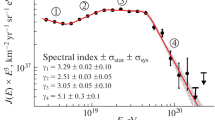Summary
With the help of new high altitude intensity measurements of Meredith, Van Allen and Gottlieb with single Geiger counters near the north geomagnetic pole, an assessment of existing knowledge of the low rigidity end of the primary cosmic ray spectrum is presented. The new Iowa rocket experiments fully confirm and substantially extend previous evidence for the marked flattening of the integral primary cosmic ray spectrum below a magnetic rigidity of about 1.5–109 volts. In particular, they indicate a complete or nearly complete absence of the major components (H, He) of the primary radiation in the following spectral regions: (a) For hydrogen, the magnetic rigidity range 1.2–109 volts to 0.18-109 volts (kinetic energy range 590 MeV to 18 MeV). (b) For helium, the magnetic rigidity range 1.2 · 109 volts to 0.37·109 volts (kinetic energy range 700 MeV to 72 MeV). The low end of these ranges is far below that attainable by any means except rocket-borne apparatus. This observed absence of low rigidity primaries is not inconsistent with a solar dipole moment as large as 0.6–1034 gauss-cm3. But there may be an entirely different physical cause. Due to the low relative abundance of primary nuclei ofZ > 2, the present data are not of sufficient accuracy to conclusively exclude their presence in the low rigidity region of the spectrum. A crucial test of the solar cut-off hypothesis is available in this connection. Preliminary roeket flights of pulse ionization chambers have been made with the intention of investigating the intensities of low rigidity heavy nuclei.
Riassunto
Servendosi dei risultati delle nuove misure d’intensità a grandi altezze eseguite da Meredith, Van Allen e Gottlieb con singoli contatori Geiger, vicino al polo geomagnetico Nord, si presenta un quadro d’insieme delle conoscenze attuali sull’estremità di bassa rigidità dello spettro primario dei raggi cosmici. I nuovi esperimenti con razzi eseguiti nello Iowa pienamente confermano e sostanzialmente ampliano le prove preesistenti di un appiattimento marcato dello spettro primario integrale dei raggi cosmici al disotto di una rigidità magnetica di circa 1,5·109 V. In particolare se ne può dedurre l’assenza completa o quasi completa dei componenti principali della radiazione primaria (H, He) nelle seguenti regioni spettrali: (a) Per l’idrogeno, l’intervallo di rigidità magnetica da 1,2·109 V a 0,18·109 V (intervallo d’energia cinetica: 590 MeV-18 MeV). (b) Per l’elio, l’intervallo di rigidità magnetica da 1,2 ·109 V a 0,37·109 V (intervallo d’energia cinetica: 700 MeV-72 MeV). L’estremità inferiore di questi intervalli è molto al disotto di quella raggiungibile con qualsi mezzo, eccetto le apparecchiature portate da razzi. L’assenza di primaria di bassa rigidità che è stata constatata non è incompatibile con un momento di dipolo solare fino a 0,6 · 1034 gauss ·cm3; può però esser dovuta ad una causa fisica del tutto differente. A causa dell’abbondanza relativamente scarsa di nuclei primari conZ > 2, i dati attualmente disponibili non sono sufficientemente precisi per escludere la loro presenza nella regione dello spettro di bassa rigidità magnetica. A tal riguardo è possibile una verifica cruciale dell’ipotesi del cut-off solare. Sono stati eseguiti con razzi lanci preliminari di camere di ionizzazione a impulso allo scopo di studiare le intensità dei nuclei pesanti di bassa rigidità.
Similar content being viewed by others
References
J. A. Van Allen:Physics and Medicine of the Upper Atmosphere (U. of. New Mexico, 1952) Chapter XIV, p. 239–266. (Ed. by C. S White and O. A. Bonson).
R. A. Alpher:Journ. Geophys. Res.,55, 437–471 (1950).
R. A. Millikan andH. V. Neher:Phys. Rev.,50, 15 (1936).
A. H. Compton andR. N. Turner:Phys. Rev.,52, 799 (1937).
H. V. Neher:Progress in Cosmic Ray Physics (Amsterdam, 1952), Chapter V, pp. 243–314. (ed. by J. G. Wilson).
H. Carmichael andE. G. Dymond:Proc. Roy. Soc., A171, 321 (1939).
M. A. Pomerantz andG. W. McClure:Phys. Rev.,86, 536 (1952)
V. Z. Peterson, H. V. Neher andE.A. Stern:Phys. Rev.,87, 240 (1952) (A).
J. A. Van Allen andS. P. Singer:Phys. Rev.,78, 819(1950);80, 116(1950).
J. A. Van Allen andS. P. Singer:Nature,170, 62 (1952); S. P. Singer:Nature,170, 63 (1952).
H. Carmichael:Proc. Echo Lake Cosmic Ray Symposium, June 23–28, 1949, Paper No. 42. (Office of Naval Research, Nov. 1949, Washington, D.C.).
A. V. Gangnes, J. F. Jenkins jr. andJ. A. Van Allen:Phys. Rev.,75, 57, 892 (1949).
H. V. Neher andS. E. Forbush:Phys. Rev.,87, 889 (1952).
J. A. Simpson, W. Fonger andL. Wilcox:Phys. Rev.,85, 366 (1952).
S. Chapman andJ. Bartels:Geomagnetism (Oxford, 1940), Vol. II, p. 644 ff.
The Rocket Panel.Phys. Rev.,88, 1027 (1952).
E. J. Schremp:Phys. Rev.,54, 158 (1938).
J. A. Van Allen andA. V. Gangnes:Phys. Rev.,78, 50 (1950).
J. A. Van Allen andA. V. Gangnes:Phys. Rev.,79, 51 (1950).
J. R. Winckler, T. Stix, K. Dwight andR. Sabin:Phys. Rev.,79, 656 (1950).
J. A. Van Allen:Phys. Rev.,84, 791 (1951).
Author information
Authors and Affiliations
Additional information
Research assisted by joint program of Office of Naval Research, Atomic Energy Commission, and Navy Bureau of Aeronautics and by Research Corporation.
Rights and permissions
About this article
Cite this article
Van Allen, J.A. The cosmic ray intensity above the atmosphere near the geomagnetic pole. Nuovo Cim 10, 630–647 (1953). https://doi.org/10.1007/BF02815287
Received:
Published:
Issue Date:
DOI: https://doi.org/10.1007/BF02815287



